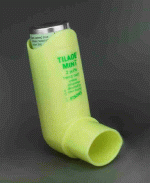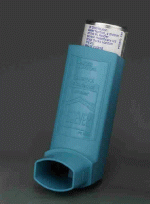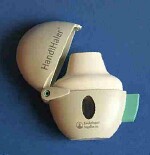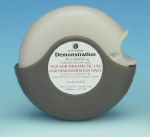Activated by a patient’s inhalation, these devices create an aerosol cloud of small particles without the need for a propellant gas. A wide range of different designs is available, and availability varies depending on which country you live in – not all devices are available worldwide. They range from single-dose units that need refilling between inhalations, through to multi-dose versions that contain up to 200 doses.
Hand-held, portable aerosol inhalers are the devices most commonly used to administer drug therapy to patients with Asthma and COPD. By creating an inhaled form of the drug, it is possible to inhale medication right into the lungs – where it can start working immediately.
A major advantage of inhaled administration is the significant reduction in the amount of drug required to produce a clinical effect – the dose needed may be only 10% of that required if it were taken by mouth. A consequence of the reduced dose is a lower risk of side-effects.
The vast majority of handheld devices can be divided into to two broad groups – pressurised metered dose and dry powder inhalers.
The route the air takes through dry powder inhalers is often complicated, and the result is that DPIs generally have a higher resistance to airflow than MDIs.
High resistance means that more effort is needed to pull the air through the inhaler. To get the full dose and the optimum quality aerosol, some dry powder inhalers need a high inspiratory flow, which means that users will need to learn to inhale forcefully and deeply before they can use the device properly,
Summary
The two major types of portable inhaler (MDI and DPI) work in very different ways. The aim with all inhalers is to try to maximise the dose that can be inhaled (quantity of drug), and produce the right size particles (quality of aerosol). DPIs and MDIs have different resistances, and inhaling with the same effort through the range of devices will produce very different inspiratory flows.
Inhaling forcefully through a DPI has been shown to result in more drug reaching the lungs, less being left in the throat, and an overall improvement in clinical effect. But other pages on this website will explain why patients should not inhale too fast when using a pMDI.
Importantly, until air actually moves through this type of inhaler, no aerosol cloud is created. The movement of air through the device when a patient inhales picks up some or all of the dry powder that has been released during preparation (sometimes called “priming”).
Like leaves on the ground and wind in autumn, fast moving air will pick up more of the dry powder than slow moving air. Above a certain speed, nearly all the dry powder will be picked up, leaving very little behind in the device.
And the energy of fast moving air has another benefit for this type of inhaler – disaggregation (or breaking up the powder into small particles). Fast moving air helps to pull apart the individual particles of powder, so that instead of a few large particles (which can’t get deep into the lungs), the aerosol cloud comprises lots of very small particles that can navigate through to the small airways where they are needed.
When the canister is actuated (by pressing it), a metered quantity of pressurised liquid is allowed to escape via the nozzle. As it escapes, it quickly vaporises, and the medication it was mixed with is dispersed into the surrounding gas. The result is an “aerosol” that contains very small particles of medication – small enough to be inhaled.
The time taken for the pressurised liquid to change into an aerosol is very short – between 0.3 and 0.5 of a second.
Traditional CFC-type aerosols leave the nozzle at speeds of between 60 and 90 miles per hour (newer HFA-type propellants are reported as being a little slower), but the further it travels away from the inhaler, the slower its speed becomes.
The aerosol propellant is a liquid that vaporises easily at room temperature – over the past 10 years the propellant has changed from a CFC-type (chlorofluorocarbon) to the more ozone-friendly HFA-type (hydrofluoroalkane).
Pressurised metered dose inhalers
The standard pressurised metered dose inhaler (MDI or pMDI) usually comprises a pressurised metal container (the “canister”) within a plastic holder (the “inhaler actuator” or “boot”).
The inhaler boot is normally made of plastic - the shape may vary slightly depending on which company manufactured it. Many are colour-coded to help identify the medication contained within, although there is no international standard on colours (by tradition, white inhaler “boots” normally signify a training device, or “placebo”, which contains no active drug).
The canister contains a mix of aerosol propellant, and medication suspension. Usually, the canister can hold a reservoir of propellant/medication mixture that is sufficient for about 200 “actuations” or doses.
Hence the emphasis on shaking your MDI thoroughly before use.
Above: Some of the dry powder and metered dose inhalers in common use
Pressurised metered dose inhalers - How they work
Right: The Handihaler® is a re-usable, single-dose dry powder inhaler





To get the drug into the lungs, the person using the inhaler must inhale the aerosol cloud as it is created; users are instructed to “press and breathe in at the same time”, so the ability to coordinate these two actions is essential.
Most MDIs are of simple design, and the airflow through them is unobstructed – as a result, they have very low resistance, which means that even a gentle effort by the user results in a high inspiratory flow.
Breath-operated MDIs
The unadapted pMDI may be difficult for some patient to use if they cannot coordinate pressing the canister and inhaling at the same time. Several manufacturers have developed “breath actuated” inhalers, which automatically press the canister (so creating an aerosol) only when the patient has started to inhale. These devices help users avoid the problem of pressing the canister at the wrong time.
The designs of the various breath-operated MDIs are more complicated than the ordinary MDI, and as a result, they have a slightly higher resistance to airflow. However, it is still low, and a gentle effort by the user will result in a high inspiratory flow.
Spacers (or “holding chambers”)
A spacer device may improve drug delivery, particularly for young children and those who have difficulty in using the pMDI. Spacers have also been shown to reduce local adverse effects from inhaled corticosteroids. They work by capturing the aerosol cloud as it leaves the MDI, and holding it ready for the patient to inhale at their leisure – they remove the need to coordinate pressing the canister and inhaling at the same time. The device also allows more time for evaporation of the propellant so that the resulting aerosol is better suited to being inhaled and travelling deep into the lung.
Large and small volume spacers are available – many patients object to carrying large bulky spacers, and small volume spacer devices have been developed to increase acceptance (and as a result, compliance).
Spacers have little or no resistance, therefore it is possible to inhale fast through them. Some have a training whistle, which sounds as a warning to the user that they are inhaling the aerosol too quickly.
